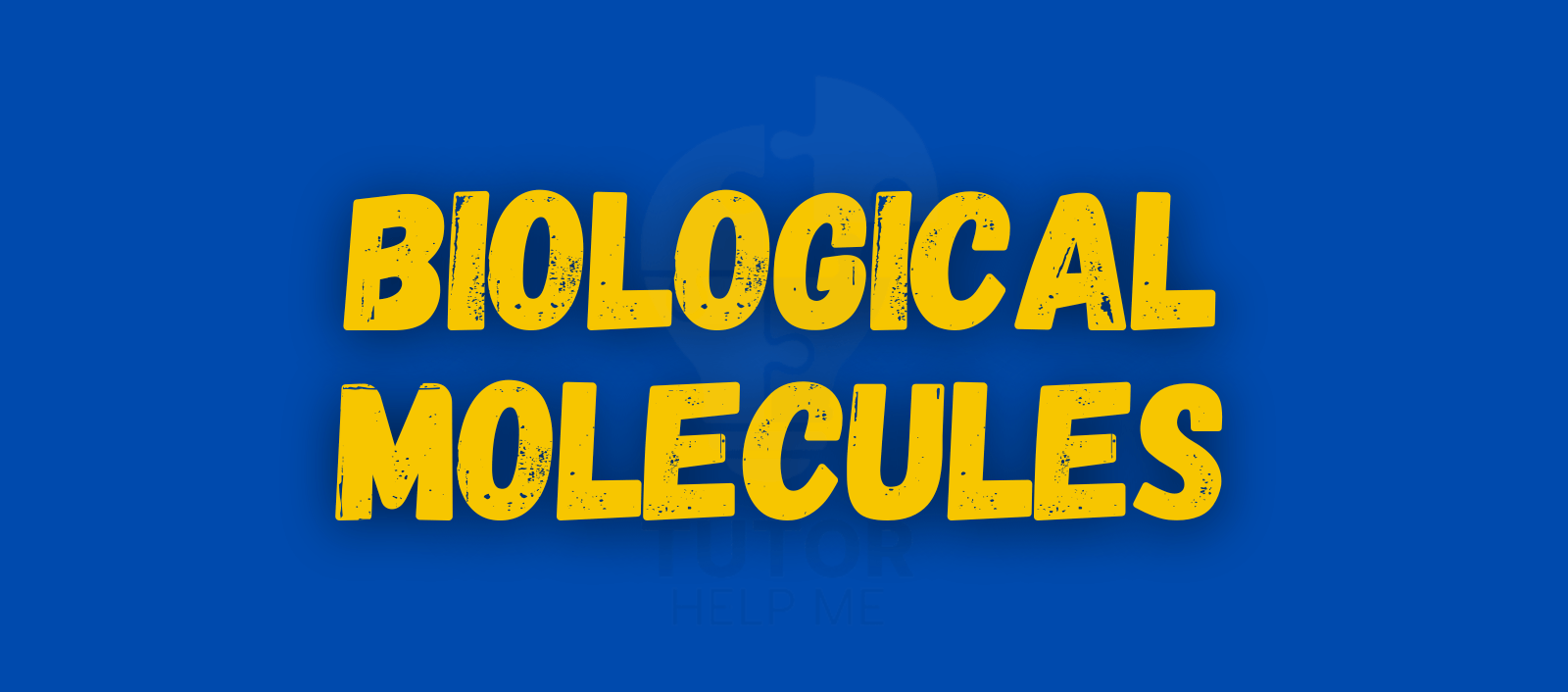Biological molecules, also known as biomolecules, are the organic compounds essential for life. They form the building blocks of all living organisms, playing a key role in biological processes such as energy production, cell structure, and genetic information storage.
These large macromolecules include proteins, carbohydrates, lipids, and nucleic acids, each performing a unique function. Some biological molecules, like enzymes, help speed up chemical reactions, while others, like DNA and RNA, store genetic information.
Why Are Biological Molecules Essential for Life?
Life depends on biological molecules because they:
✔ Provide a source of energy for growth and function.
✔ Build and repair structural components like cell membranes.
✔ Store and transfer genetic information through nucleic acids.
✔ Support metabolic reactions through enzymes.
For example,
carbohydrates such as starch and glycogen serve as a primary source of energy, while proteins like enzymes regulate biological functions.
Similarly, lipids play a major role in energy storage and membrane formation, while nucleic acids ensure genetic continuity.
Carbohydrates: Structure, Function, and Examples
Carbohydrates are biological molecules essential for life. They provide a source of energy for living organisms and serve as structural components in cells. As a key biomolecule, carbohydrates play a major role in biological processes, including metabolism and cell signaling.
These macromolecules consist of carbon, hydrogen, and oxygen atoms. Their molecular structure includes saccharides, which can be simple or complex. Complex carbohydrates are long chains of monomers that store energy and contribute to cellular structure.
What Are the Types of Carbohydrates?
Carbohydrates are classified into three main types:
Monosaccharides (Simple Sugars)
Monosaccharides are the simplest form of carbohydrates. They contain a single sugar unit and serve as building blocks for larger molecules.
Examples: Glucose, Fructose, Galactose
Functions:
- Provide quick energy.
- Act as monomers for complex carbohydrates.
- Serve as a component of nucleic acids (e.g., pentose sugar in DNA and RNA).
Disaccharides (Double Sugars)
Disaccharides consist of two monosaccharides linked by a glycosidic bond.
Examples: Sucrose, Lactose, Maltose
Functions:
- Transport energy in plants.
- Serve as an energy source in the food we eat.
- Help in digestion and metabolism.
Polysaccharides (Complex Carbohydrates)
Polysaccharides are large polymers made of repeating monosaccharide units. They serve as energy storage and structural materials.
Examples: Starch, Glycogen, Cellulose
Functions:
- Store energy in plants (starch) and animals (glycogen).
- Provide structure to plant cell walls (cellulose).
- Help in digestion by providing fibre in the diet.
What Is the Structure of Glucose?
Glucose is the most important monosaccharide and serves as a primary source of energy. Its molecular formula is C₆H₁₂O₆, and it exists in ring form in solutions.
Key Structural Features:
- Contains an aldehyde or ketone group.
- Forms hydrogen bonding with water, making it soluble.
- Acts as a precursor for polysaccharides like starch and glycogen.
Glucose undergoes polymerization to form larger polymers, which contribute to biological molecules like cellulose.
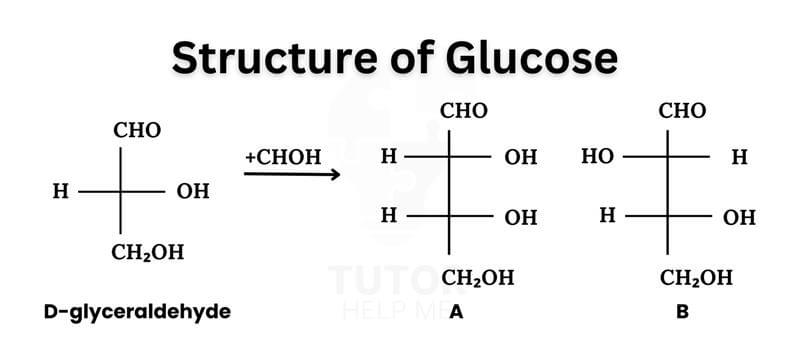
How Do Carbohydrates Provide Energy?
Carbohydrates play a key role in energy storage and metabolism. They break down into glucose, which fuels biological processes in cells.
Role of Starch in Energy Storage
- Starch is the primary energy storage carbohydrate in plants.
- It consists of unbranched chains of glucose molecules.
- Humans digest starch into glucose for ATP production.
Role of Glycogen in Energy Storage
- Glycogen is the main energy storage carbohydrate in animals.
- It is stored in the liver and muscles.
- It provides a quick energy source during physical activity.
What Are Examples of Carbohydrates in Food?
Carbohydrates are present in various foods we eat. Their types determine how they function in the body.
| Type | Examples | Function |
|---|---|---|
| Monosaccharides | Honey, Fruits | Provide quick energy |
| Disaccharides | Milk (Lactose), Sugar (Sucrose) | Serve as transportable energy sources |
| Polysaccharides | Rice, Bread, Pasta | Store energy and provide dietary fibre |
A balanced diet should include carbohydrates to support biological processes and sustain energy levels.
Lipids: Types and Biological Role
Lipids are biological molecules essential for living organisms. They are a diverse group of biomolecules that include fats, oils, phospholipids, and steroids. Unlike carbohydrates and proteins, lipids are hydrophobic, meaning they do not dissolve in water.
These macromolecules play a crucial role in energy storage, cell membrane formation, and hormone production. Lipids are found in the food we eat, including butter, oils, and dairy products.
What Are the Types of Lipids?
Lipids are classified into several types based on their structure and function.
Fats and Oils
- Fats and oils are the most common lipids in biological processes.
- Fats are solid at room temperature, while oils remain liquid.
- They serve as a source of energy, providing more than twice the energy of carbohydrates.
Example: Butter and olive oil contain fatty acids that provide long-term energy storage.
Phospholipids
- Phospholipids are the main structural components of cell membranes.
- They have a hydrophilic head and hydrophobic tails, forming a bilayer that regulates the passage of molecules.
- These lipids help maintain membrane stability in plant and animal cells.
Example: Phospholipids and cholesterol in the cell membrane control the movement of small molecules.
Steroids
- Steroids are lipid-based molecules with a complex structure.
- They function as hormones that regulate various biological activities.
- Cholesterol, an essential steroid, helps in membrane formation and hormone production.
Example: Testosterone and estrogen are steroid hormones responsible for growth and development.
What Is the Structure of a Triglyceride?
A triglyceride is a type of lipid made of:
✔ One glycerol molecule
✔ Three fatty acid tails
The fatty acid tails attach to glycerol through ester bonds, forming a stable polymer.
Key Features of Triglycerides:
- They are major structural components of fats and oils.
- Their hydrophobic nature allows energy storage in adipose tissues.
- They help in thermal insulation and protect organs.
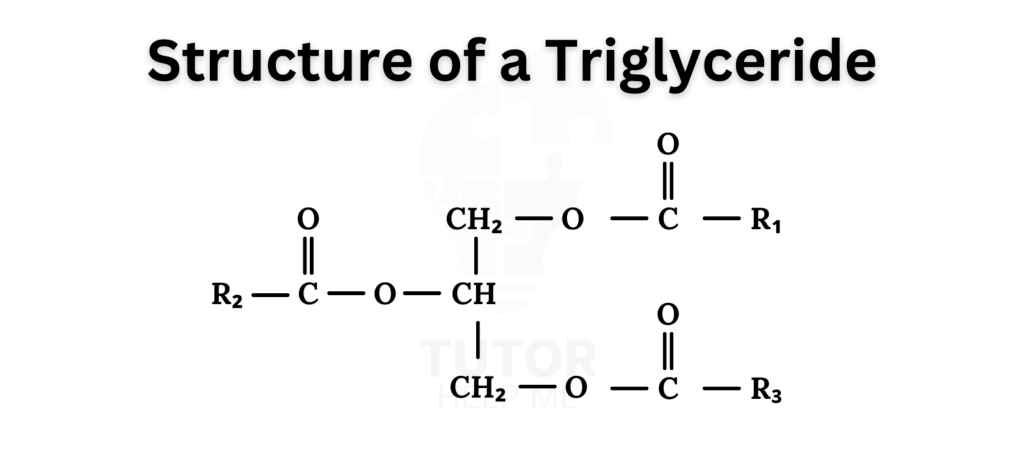
How Do Lipids Store Energy?
Lipids are the most efficient energy storage molecules in the body. Unlike carbohydrates, which provide short-term energy, lipids store energy for long-term use.
Why Are Lipids Ideal for Energy Storage?
- Lipids contain more hydrogen bonds, allowing them to store more chemical energy.
- They are compact and lightweight, making them ideal for animals and humans.
- During metabolism, fatty acids are broken down to release ATP, the body’s energy currency.
Example: Bears rely on stored lipids during hibernation as a continuous energy source.
What Is the Role of Lipids in Cell Membranes?
Lipids play a crucial role in cell membrane function. The phospholipid bilayer acts as a protective barrier and controls molecular transport.
Functions of Lipids in Membranes:
- Maintain cell structure: The bilayer provides a flexible yet strong membrane.
- Regulate molecule movement: The hydrophilic heads interact with water, while the hydrophobic tails prevent unwanted substances from entering.
- Support cell signaling: Lipids help in hormone binding and nerve transmission.
Example: The membrane in nerve cells allows the transmission of electrical signals, enabling communication between neurons.
Proteins: Structure, Function, and Importance
Proteins are essential biological molecules that play a crucial role in living organisms. These biomolecules are responsible for various biological processes, including structural support, enzyme activity, and cell signaling. Proteins are made up of amino acids, which are linked together in specific sequences to form polymers of amino acids known as polypeptide chains.
This article explores the structure, function, and importance of proteins, helping GCSE and A-Level students understand their role in biology.
What Are Proteins Made Of? (Amino Acids and Peptide Bonds)
Proteins are composed of 20 different amino acids, which act as their building blocks. Each amino acid consists of:
- A central carbon atom
- A hydrogen atom
- An amino group (-NH₂)
- A carboxyl group (-COOH)
- A variable side chain (R group)
Formation of Peptide Bonds
When one amino acid joins another, a peptide bond is formed through the removal of water in a condensation reaction. Multiple amino acids linked together create a polypeptide chain, which eventually folds into a functional protein.
How Are Proteins Structured? (Primary, Secondary, Tertiary, and Quaternary Structures)
The structure of a protein determines its function. Proteins fold into four structural levels:
Primary Structure
The primary structure is the specific sequence of amino acids in a polypeptide chain. Even a slight change in sequence can affect protein function.
Secondary Structure
The secondary structure forms when hydrogen bonds create alpha helices or beta-pleated sheets. This folding provides stability to the protein structure.
Tertiary Structure
The tertiary structure is the 3D structure of a protein, formed by interactions between side chains. This folding is stabilized by hydrogen bonding, disulfide bridges, and hydrophobic interactions.
Quaternary Structure
Some proteins have a quaternary structure, where multiple polypeptide chains combine. Hemoglobin is an example of a protein with a quaternary structure.
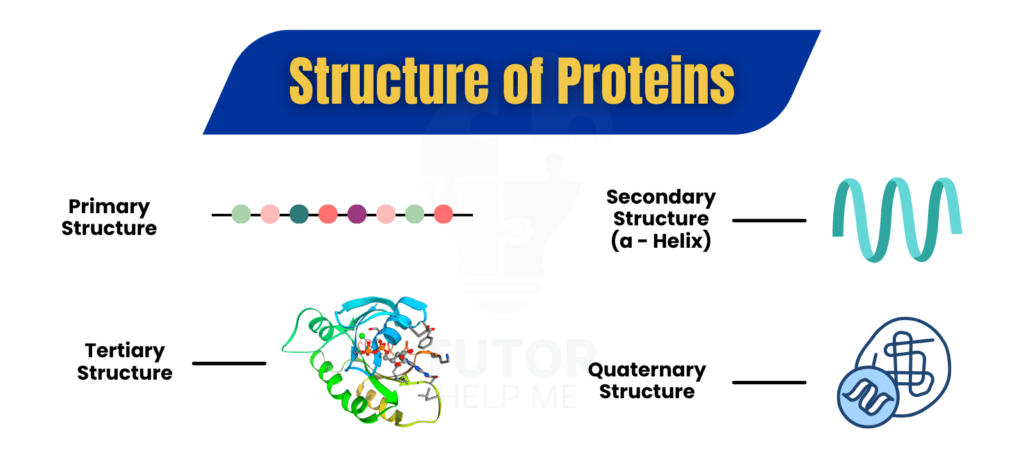
What Are the Functions of Proteins in the Body?
Proteins serve various roles in living organisms, from structural components to metabolic regulators.
Enzymes (Biological Catalysts)
Enzymes are proteins that speed up chemical reactions. Without them, many biological processes would occur too slowly. For example, amylase breaks down complex carbohydrates into simpler sugars.
Hormones (Chemical Messengers)
Certain proteins are polymers of amino acids that function as hormones, such as insulin, which regulates sugar levels in the body.
Structural Proteins (Support and Strength)
Proteins like collagen provide strength to plant cell walls, bones, and connective tissues. Keratin, found in hair and nails, is another major structural protein.
Transport Proteins (Molecule Movement)
Proteins play a role in membrane transport. For example, hemoglobin in red blood cells transports oxygen, while phospholipids and cholesterol help form cell membranes.
Immune System Proteins (Defense Against Disease)
Antibodies are proteins that help fight infections. They recognize and neutralize harmful pathogens.
What Is the Role of Enzymes in Metabolism?
Enzymes are essential in metabolism because they speed up reactions without being used up. They function through a lock and key mechanism, where the substrate binds to the enzyme’s active site.
Key Features of Enzymes:
✔ Highly specific – Each enzyme acts on a specific substrate.
✔ Reusable – Enzymes are not consumed in reactions.
✔ Affected by temperature and pH – Extreme conditions can denature enzymes.
For example, the enzyme lipase helps break down lipids into fatty acids and glycerol. Another enzyme, DNA polymerase, plays a role in DNA and RNA replication.
Nucleic Acids: DNA, RNA, and Genetic Information
Nucleic acids are biological molecules that store and transmit genetic information in living organisms. They are polymers made of smaller units called nucleotides. There are two main types:
- Deoxyribonucleic acid (DNA) – stores genetic information.
- Ribonucleic acid (RNA) – plays a role in protein synthesis.
Nucleic acids are essential biomolecules in cells, ensuring that traits are inherited and cellular functions are regulated.
What Is the Structure of DNA and RNA?
Both DNA and RNA have a polynucleotide structure, meaning they are long chains of nucleotides linked by phosphodiester bonds. Each nucleotide consists of:
A pentose sugar (deoxyribose in DNA, ribose in RNA).
A phosphate group.
A nitrogenous base (adenine, thymine, cytosine, guanine in DNA; uracil replaces thymine in RNA).
DNA Structure
DNA exists as a double-helix, where two strands run antiparallel and are held together by hydrogen bonding between complementary bases:
- Adenine (A) pairs with Thymine (T).
- Cytosine (C) pairs with Guanine (G).
The DNA structure provides stability, ensuring accurate replication and inheritance.
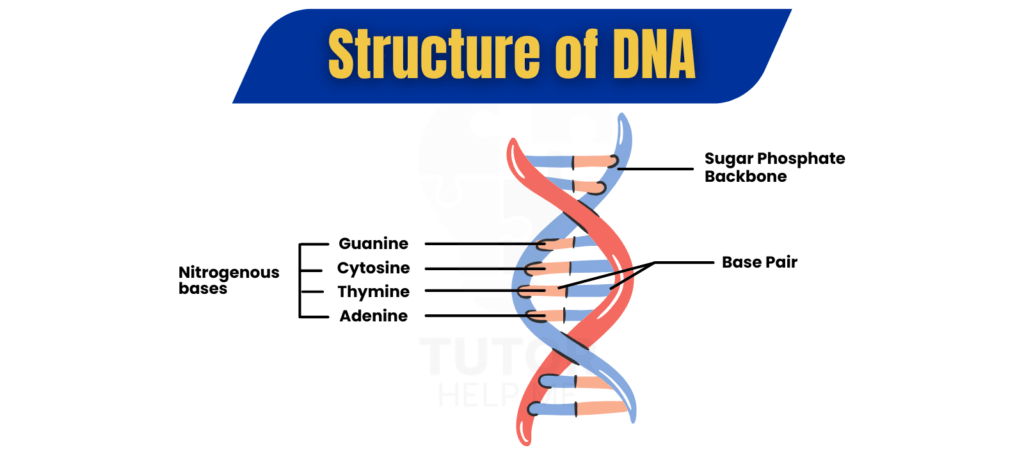
RNA Structure
RNA is single-stranded and comes in different types, including mRNA (messenger RNA), tRNA (transfer RNA), and rRNA (ribosomal RNA). These RNA molecules play a crucial role in protein synthesis.
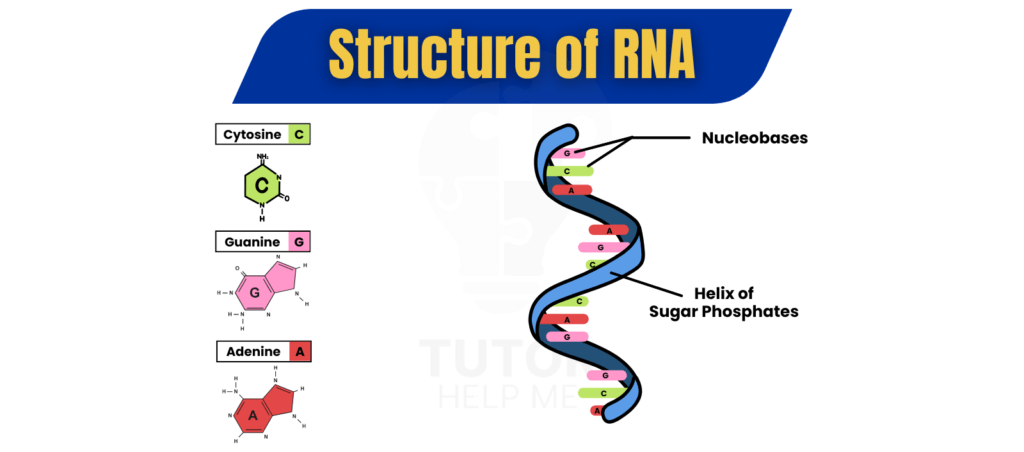
How Do Nucleic Acids Store Genetic Information?
DNA carries genetic instructions needed for cell function and inheritance. The sequence of nucleotides in DNA determines the structure of proteins, which are polymers of amino acids.
The key steps in storing and using genetic information include:
Replication – DNA copies itself before cell division.
Transcription – DNA converts into mRNA.
Translation – mRNA is used to assemble proteins in ribosomes.
The function of storing genetic information ensures that cells function correctly and pass traits to the next generation.
What Is the Role of mRNA in Protein Synthesis?
mRNA (messenger RNA) carries genetic information from DNA to ribosomes, where proteins are made. This process occurs in two main stages:
Transcription: DNA is transcribed into mRNA inside the nucleus.
Translation: mRNA interacts with ribosomes, directing them to assemble amino acids into polypeptide chains.
mRNA plays a key role in linking nucleic acids to proteins, making it an essential component in biological processes.
How Do Nucleotides Form DNA and RNA?
A nucleotide is made of three components:
✔ A pentose sugar – Either deoxyribose (in DNA) or ribose (in RNA).
✔ A phosphate group – Provides structural support.
✔ A nitrogenous base – Determines the genetic code.
The phosphate of one nucleotide bonds with the pentose sugar of another, forming a polynucleotide strand. These strands coil into the double-helix structure of DNA or remain single-stranded in RNA.
Nucleotides are the building blocks of genetic material, essential for cell growth and reproduction.
The Importance of Biological Molecules in Life
Biological molecules are essential for life. They include proteins, lipids, carbohydrates, and nucleic acids, each playing a crucial role in living organisms. These molecules provide energy, structure, and regulation for various biological processes.
How Do Biological Molecules Work Together in Cells?
Cells rely on different biological molecules to function properly. Each biomolecule has a specific role, but they all interact to maintain life processes.
- Carbohydrates provide a source of energy for cells. Monosaccharides, such as glucose, are used in cellular respiration to produce ATP.
- Lipids, including phospholipids and triglycerides, are key structural components of cell membranes. Their hydrophobic nature helps form the bilayer structure.
- Proteins act as enzymes, transporters, and structural components. They are made of polymers of amino acids, forming polypeptide chains with primary, secondary, tertiary, and quaternary structures.
- Nucleic acids, such as DNA and RNA molecules, store genetic information. DNA’s double-helix structure, with phosphodiester bonds between nucleotides, ensures accurate replication and protein synthesis.
Together, these macromolecules allow cells to grow, repair, and communicate effectively.
What Is the Relationship Between Macromolecules and Metabolism?
Metabolism is the process by which living organisms break down and build up biomolecules to maintain life.
- Carbohydrates, including starch, glycogen, and polysaccharides, undergo digestion into simple sugars for quick energy.
- Lipids, made of fatty acids and glycerol, provide long-term energy storage and insulation.
- Proteins, formed from 20 different amino acids, contribute to metabolism as enzymes. These catalysts speed up chemical reactions, such as breaking down disaccharides into monosaccharides.
- Nucleic acids, such as ribonucleic acid (RNA), are involved in protein synthesis and cellular regulation.
These biological molecules regulate anabolism (building molecules) and catabolism (breaking molecules), ensuring cells receive necessary nutrients and energy.
How Do Biological Molecules Contribute to Human Health?
A balanced diet provides essential biological molecules needed for health.
- Carbohydrates, especially complex carbohydrates, supply sustained energy. Foods rich in polysaccharides, such as whole grains and vegetables, support digestion.
- Proteins, found in meat, beans, and dairy, help build muscles and enzymes. Proteins like hemoglobin transport oxygen in the blood.
- Lipids, including phospholipids and cholesterol, contribute to cell membranes and hormone production. Fatty acid tails in triglycerides store energy for long-term use.
- Nucleic acids, such as deoxyribonucleic acid (DNA), maintain genetic stability and enable cell division.
Deficiencies in biological molecules can lead to health issues, such as protein malnutrition, lipid imbalances, and carbohydrate deficiencies. A well-balanced diet ensures optimal cell function and overall health.
Summary and Key Takeaways
Why Are Biological Molecules Essential for Survival?
Without biological molecules, life would not exist. These biomolecules support growth, energy production, and genetic continuity. They are involved in all biological processes, from digestion to reproduction.
How Do These Molecules Contribute to Growth, Energy, and Genetic Information?
- Carbohydrates fuel metabolic reactions and power cells.
- Lipids serve as energy reserves and form protective barriers.
- Proteins enable enzymatic reactions and structural development.
- Nucleic acids store and transmit genetic material, guiding cellular function.
Each biological molecule plays a unique role, ensuring proper growth, repair, and reproduction in living organisms.
What Are Some Key Differences Between Lipids, Carbohydrates, Proteins, and Nucleic Acids?
| Type of Biomolecule | Function | Example |
|---|---|---|
| Carbohydrates | Source of energy for cells | Glucose, Starch |
| Lipids | Energy storage and membrane structure | Triglycerides, Phospholipids |
| Proteins | Enzymes, structural components | Hemoglobin, Enzymes |
| Nucleic Acids | Store genetic information | DNA, RNA |
These biological molecules interact to maintain metabolism, cellular structure, and genetic stability. Understanding their functions helps in biology, nutrition, and medicine.
Read more Plant Reproduction | Sexual and Asexual reproduction Methods

